



Milk analysis
 |
Somatic cell counter LACTOSCAN SCCThe number of somatic cells (SCC) is one of the internationally recognized standards for milk quality control and is also a useful indicator for mastitis presence. Portable Lactoscan SCC is based on direct fluorescent, low magnification microscopic somatic cell counting. Lactoscan SCC uses a very sensitive fluorescent dye Sofia Green, LED optics CCD technologies for capturing in order to make the cells analysis more accurate, reliable and fast. Mostly, the objective selectiveness of Lactoscan SCC is combined with the permanent high stability of the different mechanical, electronic, optical and chemical components of the system, which provides almost identical results during the whole duration of machine's use. Analysis time: < 1 minute Capacity: > 60 tests per hour Measuring range: 10 000 to 10 000 000cell/mL Deviation:SCC (cell/mL) CV% 100 000 5% 400 000 3% 600 000 2% Weight: 5.3 kg
|
||||||||||||||||||||||||||||||||||||||||||||||||||||||||||||||||||||||||||||||||||||||||||||||||||||||
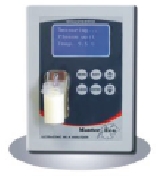 |
Milk analyser Master Ecowith one peristaltic pump FAT from 0% to 25% Solids-non-fat (SNF) : 3% to 15% Density from 1015 to 1160 kg/m3 Protein : 2% to 7% Lactose : 0.01% to 6% (accuracy +/- 0.1 % lactose) Salts : 0.4% to 1.5% Added water : 0% to 70% Freezing point from -0.400 to -0.700°C Sample temperature from 5°C to 40°C optional: pH measurement, bluetooth communication for cow milk, sheep milk, buffalo milk, camel milk, lama milk, restored milk, UHT, cream, whey and buttermilk
|
||||||||||||||||||||||||||||||||||||||||||||||||||||||||||||||||||||||||||||||||||||||||||||||||||||||
 |
Milk analyser Master ProfessionalFAT from 0% to 25% (option to 45%) Solids-non-fat (SNF) from 3% to 15% (option to 40%) Density from 1015 to 1160 kg/m3 Protein from 2% to 7% Lactose from 0.01% to 6% (accuracy +/- 0.1 % lactose) Salts from 0.4% to 1.5% Added water from 0% to 70% Freezing point from -0.400 to -0.700°C Sample temperature from 5°C to 40°C optional: pH and conductivity measurement, Clock with date, memory for the last 500 measurements, daily and monthly report, printer for cow milk, sheep milk, buffalo milk, camel milk, lama milk, restored milk, UHT, cream, whey and buttermilk
|
||||||||||||||||||||||||||||||||||||||||||||||||||||||||||||||||||||||||||||||||||||||||||||||||||||||
 |
Milk analyser Lactoscan Farm EcoFat: 0.01 to 25% ±0.1% Solids-non-fat (SNF): 3 to 15% ±0.15% Density: 1015 to 1040 kg/m3 ±0.3kg/m3 Protein: 2% to 7% ±0.15% Lactose: 0.01% to 6% ±0.2% Added water: 0% to 70% ±3 % Milk sample temperature: 1°C to 40 °C ±1% Freezing point: -0.4°C to -0.7°C ±0.001% Salts: 0.4% to 1.5% ±0.05% Result in 60 seconds included in the package
Options: printer for cow milk, sheep milk, buffalo milk, camel milk, lama milk, restored milk, UHT, cream, whey and buttermilk |
||||||||||||||||||||||||||||||||||||||||||||||||||||||||||||||||||||||||||||||||||||||||||||||||||||||
 |
Milk analyser Lactoscan SP and SPAFat: 0.01 to 25% ±0.1% Solids-non-fat: (SNF) 3 to 15% ±0.15% Density: 1015 to– 1040 kg/m3 ±0.3kg/m3 Protein: 2% to 7% ±0.15% Lactose: 0.01% to 6% ±0.2% Added water: 0% to– 70% ±3% Milk sample temperature: 1°C to 40 °C ±1°C Freezing point: -–0.4°C to -0.7°C ±0.001°C Salts: 0.4% to 1.5% ±0.05% Result in 60 seconds included in the package
Options: printer, pH measurement (0 to 14 ±0.05), conductivity measurement (3 to 14 mS/cm ±0.05), total solid (0 to 50 %±0.17 %), measuring high fat samples (cream) up to 45 %, external keypad, USB flashdrive for cow milk, homogenized pasteurized cow milk, sheep milk, goat milk, buffalo milk, camel milk, lama milk, restored milk, UHT, cream, whey and buttermilk Version SPA: automatic daily cleaning with alcaline solution |
||||||||||||||||||||||||||||||||||||||||||||||||||||||||||||||||||||||||||||||||||||||||||||||||||||||

|
Milk analyser Lactoscan S and SAFat: 0.01 to 25% ±0.1% Solids-non-fat: (SNF) 3 to 15% ±0.15% Density: 1015 to 1040 kg/m3 ±0.3kg/m3 Protein: 2% –to 7% ±0.15% Lactose: 0.01% to 6% ±0.2% Added water: 0% to 70% ±3% Milk sample temperature: 1°C –to 40 °C ±1°C Freezing point: –-0.4°C to -0.7°C ±0.001°C Salts: 0.4% to 1.5% ±0.05% Result in 60 seconds included in the package
Options: internal or external printer, pH measurement (0 to 14 ±0.05), conductivity measurement (3 to 14 mS/cm ±0.05), total solid (0 to 50 %±0,.17 %), measuring high fat samples (cream) up to 45 %, external keypad, USB flashdrive, carrying case for cow milk, homogenized pasteurized cow milk, sheep milk, goat milk, buffalo milk, camel milk, lama milk, restored milk, UHT, cream, whey and buttermilk Version SA: automatic daily cleaning with alcaline solution |
||||||||||||||||||||||||||||||||||||||||||||||||||||||||||||||||||||||||||||||||||||||||||||||||||||||
 |
Milk analyser Lactoscan LAFat: 0.01 to 25% ±0.1% Solids-non-fat: (SNF) 3 to 40 % ±0.15% Density: 1015 to 1160 kg/m3 ±0.3kg/m3 Protein: 2% to 15% ±0.15% Lactose: 0.01% to 20% ±0.2% Added water: 0% to 70% ±3% Milk sample temperature: 1°C –to 40 °C ±1°C Freezing point: –-0.4°C to -0.7°C ±0.001°C Salts: 0.4% to 4% ±0.05% Result in 50 seconds Automatic cleaning with alcaline solution included in the package
Options: external printer, pH measurement (0 to 14 ±0.05), conductivity measurement (3 to 14 mS/cm ±0,05), total solid (0 to 50 %±0.17 %), measuring high fat samples (cream) up to 45 %, external keypad, USB flashdrive, carrying case for cow milk, homogenized pasteurized cow milk, sheep milk, goat milk, buffalo milk, camel milk, lama milk, restored milk, UHT, cream, whey and buttermilk |
||||||||||||||||||||||||||||||||||||||||||||||||||||||||||||||||||||||||||||||||||||||||||||||||||||||
 |
Milk analyser Lactoscan MCCFat: 0.01 to 25% ±0.1% Solids-non-fat: (SNF) 3 to 40 % ±0.15% Density: 1015 to 1160 kg/m3 ±0.3kg/m3 Protein: 2% to 15% ±0.15% Lactose: 0.01% to 20% ±0.2% Added water: 0% to 70% ±3% Milk sample temperature: 1°C to 40 °C ±1°C Freezing point: –-0.4°C– to -0.7°C ±0.001°C Salts: 0.4% to 4% ±0.05% Result in 50 seconds included in the package
Options: internal or external printer, pH measurement (0 to 14 ±0.05), conductivity measurement (3 to 14 mS/cm ±0,05), total solid (0 to 50 %±0.17 %), measuring high fat samples (cream) up to 45 %, external keypad, USB flashdrive, carrying case, scale for cow milk, homogenized pasteurized cow milk, sheep milk, goat milk, buffalo milk, camel milk, lama milk, restored milk, UHT, cream, whey and buttermilk Version SA: automatic daily cleaning with alcaline solution |
||||||||||||||||||||||||||||||||||||||||||||||||||||||||||||||||||||||||||||||||||||||||||||||||||||||
 |
Milk analyser Lactoscan LWWith Windows touchscreen tablet Fat: 0.01 to 45% (cream) ±0.1% Solids-non-fat: (SNF) 3 to 15 % ±0.15% Density: 1000 to 1160 kg/m3 ±0.3kg/m3 Protein: 2% to 15% ±0.15% Lactose: 0.01% to 6% ±0.2% Added water: 0% to 70% ±3% Milk sample temperature: 1°C to 40 °C ±1°C Freezing point: –-0.4°C– to -0.7°C ±0.001°C Salts: 0.4% to 1.5% ±0.05% Result in 50 seconds included in the package
Options: internal or external printer, pH measurement (0 to 14 ±0.05), conductivity measurement (3 to 14 mS/cm ±0,05), total solid (0 to 50 %±0.17 %), measuring high fat samples (cream) up to 45 %, external keypad, USB flashdrive, carrying case, scale for cow milk, homogenized pasteurized cow milk, sheep milk, goat milk, buffalo milk, camel milk, lama milk, restored milk, UHT, cream, whey and buttermilk Version LAWS: automatic daily cleaning with alcaline solution |
||||||||||||||||||||||||||||||||||||||||||||||||||||||||||||||||||||||||||||||||||||||||||||||||||||||
 |
Milk analyser Lactoscan MCCWWith Windows touchscreen tablet Fat: 0.01 to 25% ±0.1% Solids-non-fat: (SNF) 3 to 15 % ±0.15% Density: 1000 to 1160 kg/m3 ±0.3kg/m3 Protein: 2% to 7 ±0.15% Lactose: 0.01% to 20% ±0.2% Added water: 0% to 70% ±3% Milk sample temperature: 1°C to 40 °C ±1°C Freezing point: -0.4°C to -0.7°C ±0.001°C Salts: 0.4% to 1.5 % ±0.05% Result in 50 seconds included in the package
Options: printer, pH measurement (0 to 14 ±0.05), conductivity measurement (3 to 14 mS/cm ±0,05), total solid (0 to 50 %±0.17 %), measuring high fat samples (cream) up to 45 %, external keypad, USB flashdrive, carrying case, scale for cow milk, homogenized pasteurized cow milk, sheep milk, goat milk, buffalo milk, camel milk, lama milk, restored milk, UHT, cream, whey and buttermilk Version MCCWS: with an ultrasonic stirrer for stirring the milk before analysis |
||||||||||||||||||||||||||||||||||||||||||||||||||||||||||||||||||||||||||||||||||||||||||||||||||||||
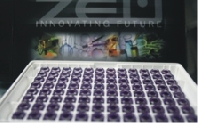 |
Detection of antibiotics in milk- Eclipse 3 GThe ECLIPSE kit is a broad-range screening test designed for the qualitative detection of antibiotics in milk. The method has been validated following the ISO 1369:2003(E) and is based on the inhibition of microbial growth. It is supplied in a microtiter plate format where each well contains agar medium spread with Geobacillus stearothermophilus. When the plate is incubated at 65ºC spores germinate and cells grow producing acid and changing the agar pH. Variations of pH will produce changes of the agar colour from blue (purple) to yellowish. When milk samples contain inhibitors at higher concentrations than the detection limit, microorganisms will not grow and neither colour changes will be observed. Kit features: One step assay, Compliance with MRLs (Maximum Residue Limits), Broad range of antibiotics detection, Ready-to-use Format: 96-well microplate (divisible into individual wells) Sample kind: Cow, sheep and goat milk Results: Visual or photometrical reading
|
||||||||||||||||||||||||||||||||||||||||||||||||||||||||||||||||||||||||||||||||||||||||||||||||||||||
 |
Detection of antibiotics in milk- Eclipse Farm 3 GThe ECLIPSE Farm kit is a broad-range screening test designed for the qualitative detection of antibiotics in milk. The method has been validated following the ISO 1369:2003(E) and is based on the inhibition of microbial growth. It is supplied in a single tubes format where each tube contains agar medium spread with Geobacillus stearothermophilus. When the tubes are incubated at 65ºC spores germinate and cells grow producing acid and changing the agar pH. Variations of pH will produce changes of the agar colour from blue (purple) to yellowish. When milk samples contain inhibitors at higher concentrations than the detection limit, microorganisms will not grow and neither colour changes will be observed. Kit features: One step assay, easy to handle tubes, individual tests, broad range of antibiotics detection, compliance with MRLs, ready-to-use (delivered with test tubes and disposable pipettes). Format: 25 and 50 tests tubes Test time: 2.15 - 2.45 h Sample kind: Cow, sheep and goat milk Results: Visual
|
||||||||||||||||||||||||||||||||||||||||||||||||||||||||||||||||||||||||||||||||||||||||||||||||||||||
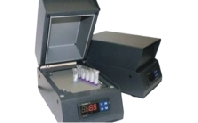 |
FX - BLOCK HEATERIncubation chamber for Eclipse kits Dimensions: 220x 130 x 135 mm Weight : 3.5 kg Power: 220V, 4A Temperature range: 30 ºC - 75ºC Warming time: 30 minute
|
||||||||||||||||||||||||||||||||||||||||||||||||||||||||||||||||||||||||||||||||||||||||||||||||||||||
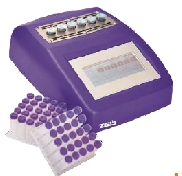 |
e-Reader for Eclipsee-Reader is an autonomous system that coupled to Eclipse Farm3G tests allows to simplify and standardize the screening of a broad range of antibiotics in milk. It can aslo be used for the screening of, meat, eggs, kidney and feed with the Explorer 2.0 kit. It is a bacteria inhibition growth tests, where the presence and absence of antibiotics is detected by changes in the media colour. An internal software integrates color and time parameters to determine the endpoint of the assay. e-Reader also interprets the results as qualitative and numerical values. The results are stored to guarantee full traceability. Working temperature: 65 ºC Automatic stop of the assay. The results are displayed on screen at the end of the incubation time. Standardrizes results and avoids mistakes 2 versions:
|
||||||||||||||||||||||||||||||||||||||||||||||||||||||||||||||||||||||||||||||||||||||||||||||||||||||
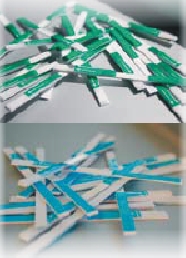 |
Detection of milk-mixture - IC BOVINO, IC CAPRINO and IC-BUFFALOIC BOVINO kit is a qualitative test to detect the presence of cow's milk in goat or sheep's milk. The test is an immunoassay based on the detection of bovine immunoglobulins (IgG) in milk and cheese samples. IC CAPRINO kit is a qualitative test to detect the presence of goat's milk in sheep's milk. The test is an immunoassay based on the detection of caprine immunoglobulins (IgG) in milk and cheese samples. IC BUFFALO kit is a qualitative test to detect the presence of cow's milk in buffalo's milk. The test is an immunoassay based on the detection of caprine immunoglobulins (IgG) in milk and cheese samples
|
||||||||||||||||||||||||||||||||||||||||||||||||||||||||||||||||||||||||||||||||||||||||||||||||||||||
 |
IC-Reader for IC BOVINO and IC CAPRINOThe IC strip kits are qualitative tests, based on specific IgG, for milk species identification. They are on-site tests easily used by any operator without additional equipment. The new IC-Reader can be used with the IC tests kits to obtain objective and standardized results. Results will be displayed on the screen as negative (NEG), positive (POS) or high positive (HPOS). Results can also be stored and downloaded to your laptop or PC using the software provided. Individual methods are designed for both IC Bovino and IC Caprino. Every batch is calibrated individually and will have a specific method.nt> The device is portable and can be used with batteries or connected to your computer. Limit of detection in milk: Bovino 0,25% of mixture / Caprino 0,5% of mixture.
|
||||||||||||||||||||||||||||||||||||||||||||||||||||||||||||||||||||||||||||||||||||||||||||||||||||||
 |
Detection of milk-mixture - RC-BOVINO and RC-CAPRINOMilk with high economic value is commonly adulterated with milk from species of lower cost. This adulteration can be important for cheese makers, unknown milk mixtures produce changes in the final sensory properties and reduce the product quality. Also, pure cheese cannot contain milk from other species. Sheep milk is more expensive than goat or cow's milk and tends to be adulterated with those of lower cost. RC kits are ELISA tests for quantitative determination of milk mixtures. RC BOVINO kit is a quantitative test to detect the presence of cow's milk in goat or sheep's milk. The test is an immunoassay based on the detection of bovine immunoglobulins (IgG) in milk and cheese samples. RC CAPRINO kit is a quantitative test to detect the presence of goat's milk in sheep's milk. The test is an immunoassay based on the detection of caprine immunoglobulins (IgG) in milk and cheese samples.
|
||||||||||||||||||||||||||||||||||||||||||||||||||||||||||||||||||||||||||||||||||||||||||||||||||||||
 |
Milk test strips for neutralizers, hydrogen peroxide and urea- Milk SecurityThe neutralizers, hydrogen peroxide and urea in milk samples influence on the quality of milk and milk products. Milk security test strips are rapid and sensitive dry strips to detect milk adulteration. Test for neutralizers: Neutralizers like sodium bicarbonate, sodium hydroxide, sodium carbonate or hydrated lime are often added to milk. Usually they are added to milk to increase the lactometer reading. Test for hydrogen peroxide: The impregnate test zone with enzyme and chromogen ensured very selectivity determination of hydrogen peroxide. Hydrogen peroxide (H2O2) is a well-known powerful oxidizer. Its capabilities as a disinfectant are superior than chlorine (Cl2) and chlorine dioxide (ClO2). Hydrogen peroxide is commonly used in dairy industries. Peroxide indicator strips can be used to ensure that any residual peroxide sanitizer has been fully removed before filling. Test for urea concentration: Urea is generally added in the preparation of milk to raise the solids-not-fat (SNF) value. It has been proven that urea added to milk at a higher concentration reduces the activity of hydrogen ions and increases the pH of the milk. Normal values of urea in milk are from 0 to 0.07%. Urea concentration above 0.07% means that the milk was adulterated with urea.
|
||||||||||||||||||||||||||||||||||||||||||||||||||||||||||||||||||||||||||||||||||||||||||||||||||||||
 |
Milk test strips for titratable acidity and pH- MILK SECURITYThe test strip has a green-blue indication area. Through it can be determined the titratable acidity of milk in three scales: 0Th (Thörner degrees) and 0D (Dornic degrees) and 0SH (Soxhlet Henkel degrees). Measurement is valid in the absence of neutralizers. The measured values of titratable acidity correspond to certain values of pH. Fresh cow's milk has a pH around 6.6 – 6.8. Values greater than 6.8 indicate that the milk has coagulated and a value below 6.5 indicates the presence of colostrums or bacterial contamination.
|
||||||||||||||||||||||||||||||||||||||||||||||||||||||||||||||||||||||||||||||||||||||||||||||||||||||
 |
Detection of urea in milkAdulteration of commercial urea milk is made in milk to increase the non protein nitrogen content. A too much urea concentration in food can lead to certain diseases. The test can be used at ambiant temperature (2 to 42 °C). The kit must be stored in 2-8 C. Clean milk with no adulteration show a violet ring formed on the surface of the milk sample, adulterated milk show a pink fragment formed on the surface of the milk sample. Sensitivity limit > 70 mg/ 100 mL urea in milk (normal levels of urea in milk are from 20 to 70 mg/ 100 mL). Method: In a ria tube add 4 mL of raw milk, 50 uL of reagent R2 and 200 uL of reagent R1. In 5 seconds you can read the results. Packaging: 1 kit is egnough for 50 test
|
||||||||||||||||||||||||||||||||||||||||||||||||||||||||||||||||||||||||||||||||||||||||||||||||||||||
 |
Detection of neutralizer in milkThe new milk neutralization by means of enhancers allows direct colorimetric determination of the presence of added neutralizers (such as NADH, KOH, carbonates, bicarbonates, ammonia, various alkalis, etc.) in milk, whey or cream. These banned substances can be added to fresh or badly preserved milk in order to correct pH and acidity to optimum levels, and thus show that milk is recently salted or perfectly preserved. It is the most sensitive test for neutralizing agents detection, with immediate results in 1 second and with 2 years of expiry date. The sample is poured into a pre-filled sample tube provided up to 10 mL., then 2-3 drops of a specific and ready-to-use R reagent are added. An immediate colorimetric reaction indicates the test result, clearly and without doubt. Specifications
Packing
|
||||||||||||||||||||||||||||||||||||||||||||||||||||||||||||||||||||||||||||||||||||||||||||||||||||||
Lactopast Biomedix Detergents DetectorIt can detect the presence of any detergents in the milk vessels after their cleaning process. Also, it can detect the presence of detergents in raw milk. Sensitivity limit 0.0125%. Procedure Place 5 mL of raw milk into a prefilled tube, close the cap and shake gently. In 60 seconds, appearance of violet color indicates the presence of detergents in the raw milk In 60 seconds, appearance of gray-faint violet color indicates the absence of detergents in raw milk.
|
|||||||||||||||||||||||||||||||||||||||||||||||||||||||||||||||||||||||||||||||||||||||||||||||||||||||
 |
Rapid screening for antibioticsAntibiotic residues in milk pose a major problem in dairy industries because they can inhibit or slow down starter cultures for yoghurt and cheese production. With these kits it is easy to control the milk in 10 minutes. When positive it is advised to confirm with another test. advantage: quick, no need of extra equipement storage: 2-8 °C, protected from sun and moisture, do not freeze, shelf life= 12 months packaging: 12 x 8 tests
MRL: Maximum Residue Limit LOD: Limit Of Determination Packaging:
|
||||||||||||||||||||||||||||||||||||||||||||||||||||||||||||||||||||||||||||||||||||||||||||||||||||||
 |
Pasteurisation Test LACTOPAST BIOMEDIXIt is a rapid phosphatase test for the detection of alcaline phosphatase in milk, whey, cream and butter. The test allows the testing of sufficient pasteurisation treatment of milk and related products, and the detection of raw milk in pasteurized milk. Sensitivity of the test is as follows: For measurement from 5 seconds up to 300 seconds: 3.5 mU/L ALP One kit is enough for 100 tests. For the test procedure there is no need of thermal preparation of the sample. The test works at temperatures 2-42 °C. The kit with the reagents must be stored at the refrigerator at a temperature 2-8 °C. Comparison with other tests
|
||||||||||||||||||||||||||||||||||||||||||||||||||||||||||||||||||||||||||||||||||||||||||||||||||||||
 |
Lactopast Biomedix Oxidase kit for UHT milkThis is a kit for the quick qualitative test of peroxidase in cow, goat, sheep milk and cream samples. It allows the operator to determine the presence/ absence of this enzyme in UHT-treated milk or cream. The test can be performed very easily, without the need of any equipment and without any specific technical background. The colorimetric reaction is visible in few seconds. Results:
|
||||||||||||||||||||||||||||||||||||||||||||||||||||||||||||||||||||||||||||||||||||||||||||||||||||||
 |
Triple Quik Test (Salmonella+Brucella+Proteus)It is a slide agglutination test for the qualitative and semi-quantitative detection of antibodies anti-Salmonella, Brucella and certain Rickettsias in raw milk. The reagents, standardized suspensions of killed and stained bacteria, agglutinate when mixed with samples containing the homologous antibody. The test can be performed in all foods (each food must be processed accordingly before testing)
|
||||||||||||||||||||||||||||||||||||||||||||||||||||||||||||||||||||||||||||||||||||||||||||||||||||||
Lactopast Biomedix Catalase TestThe test demonstrate the presence of catalase, which an enzyme that catalyse the release of oxygen. It is to differentiate bacteria producing a catalse, like staphylococci, from non catalase producing bacteria, like streptococci. The kit Ref. 82021 contains material for 600 tests
|
|||||||||||||||||||||||||||||||||||||||||||||||||||||||||||||||||||||||||||||||||||||||||||||||||||||||
Lactopast Biomedix Mastitis TestIt is a rapid accurate test to help determine somatic cell counts in a specific cow. The test is developed to sample individual quarters to determine the presensce of mastitis. The test can be conducted on bucket and bulk tank milk samples to help determine somatic cell counts of the entire herd. Application columns are available for goats and sheeps. The kit Ref. 82121 contains material for 500 tests and 2500 tests. Histoplastin ErythroForte Special herbal mixture cream for the effective treatment of mastitis. 100 % natural product with no chemical excipients or other synthetic chemicals, binds free radicals, restores skin dammage without leaving any signs, increases collagen, elastin and involucrine. The kit Ref. 82091 contains 50 ml of product.
|
|||||||||||||||||||||||||||||||||||||||||||||||||||||||||||||||||||||||||||||||||||||||||||||||||||||||
Hestia Milk Samples Preservation ReagentIt is a liquid reagent for the milk samples preservation from the site of collection until their examination at the reference laboratory. The reagent consists of 8 x 30mL. R + 1 x 10 mL. R with a user friendly dropper which releases 50 uL reagent R/ drop. One drop is adequate for 40 mL. of milk. The dropper device reduces the possibility of cross contamination, reduces the secondary costs (e.g. use of gloves). After the addition of one drop of reagent into the milk sample vial, seal the vial with the cap, mix the content gently and transport it to the laboratory. storage: romm temperature shelf life: 34 months package: 8 x 30mL. R + 1 x 10 mL, for about 5000 samples
|
|||||||||||||||||||||||||||||||||||||||||||||||||||||||||||||||||||||||||||||||||||||||||||||||||||||||
Measurement of protein concentration in cheeseProtein content of cheese is classically determined through the analysis of its nitrogen content done by the Kjeldahl method, and the obtained result is multiplied by a number named nitrogen conversion factor (NCF). The value of NCF is related to the amino acid composition of the protein source and to the eventual presence of side groups covalently bound to some amino acids of the protein chain. Protein in cheese kit developed by MenidiMedica offers a reliablealternative, for the user, which gives fast, easy, accurate, repeatable quantitative results. Required equipment (not provided)
|
Oberdorfstrasse 51
CH 3930 Eyholz
tel + 41 27 946 80 18
fax + 41 27 946 86 42
info@sysmatec.ch



